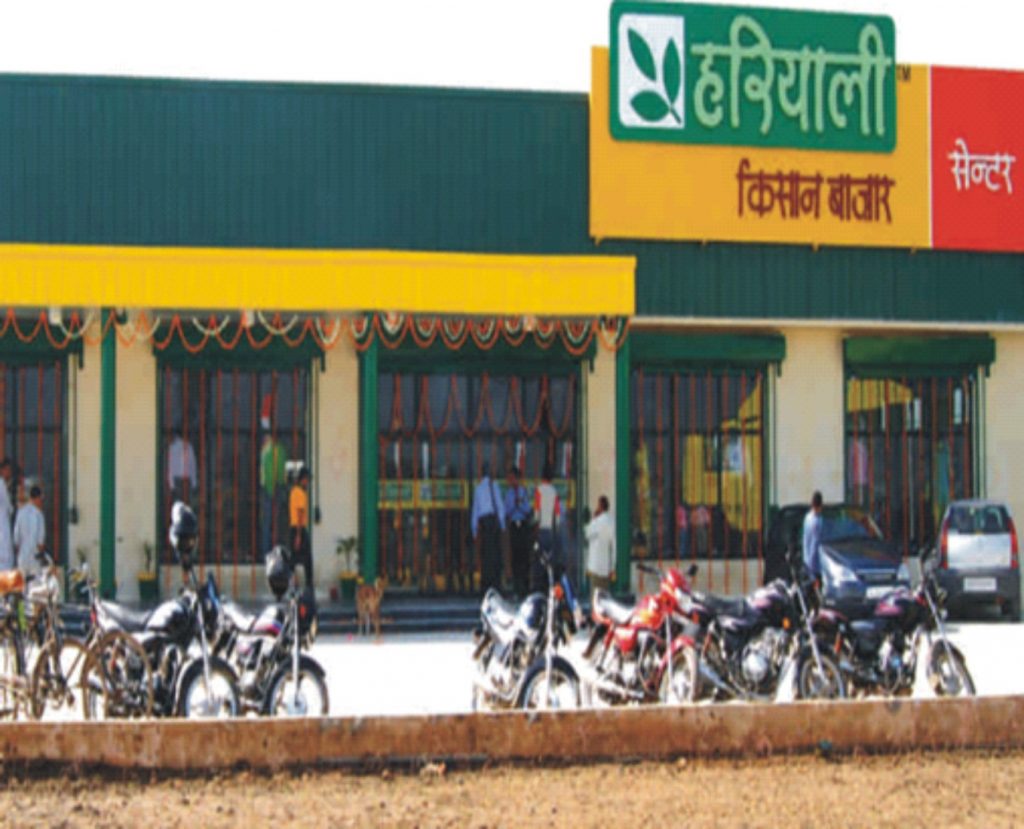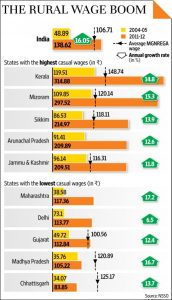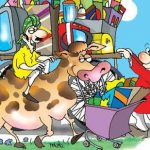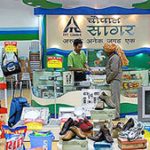 Rural Retail Promises Growth
Rural Retail Promises Growth
Rural India has not been exposed to the far flung world. The traditions, arts, culture, religious mindset, craftsmanship etc is nourished as well as cherished in the deep villages in India. The amazing agricultural environment in the villages, the simplicity of people and their culture and the pollution less surroundings leads the urbanites to travel to the villages to unwind their stress and fatigue. Fresh agricultural produce, organic food, the ethnicity, small village enterprises selling handicrafts, the muddy pathways, small houses, some beautiful monuments, forts, lakes which are not hyped – yet are very attractive – all of this attracts some foreigners also to rural Indian destinations quite often. It is sad that the Tourism Development Ministry in India has not prioritized developing the village tourism so far. India’s 70% population lives in 6,27,000 villages in rural areas; as per the National Council for Applied Economic Research (NCAER) study, and there are as many ‘middle income and above’ households in the rural areas as in the urban areas.
No wonder, the FMCG marketers are drawn to the rural destination with their innovative strategies of sales and marketing. One fact regarding the rural people is that they live life moment to moment. They can’t take decisions beyond a week, a month or more; this is due to their limitation to reasoning – they live very happily in the present. They fight uncertainties so often, that they are grounded in the present. The uncertainties of the weather, uncertainties of crop yield, and uncertainties of aid from government make the rural citizens unenthusiastic about new openings and opportunities. Just 2 days back, we heard about the disaster in Malin village in the Ambegaon tehsil of Pune district where an entire village got flattened by a landslide that hit early Wednesday morning after torrential rains.
About 17 people got killed and 200 feared trapped as 44 houses got trapped under the debris. Among those trapped were 60 women and 60 children. Though the landslide occurred at 4am, news of the damage reached the district administration only after several hours as the village is part of a remote tribal belt. Hence, people in rural areas live from moment to moment.
 However, because of the TV and the booming media, even the economically lower class of the Indian population craves for a lifestyle like the well-to-do people they see on the TV. Rural crowd is no exception to this. Advertising in regional languages on the television, using humor and appealing jingles works a great deal here. The recall value of products which are continuously advertised is great as a recent study shows that disposable income is better than before and rural consumers are liberally splurging it. Fast food and drinks have acquired a greater “cool” image for them. The study also shows that over the years, the expenditure on non-food items has grown faster than the expenditure on food items. The rural India is witnessing a great change in the lifestyles and buying patterns of consumers. Convenience foods like instant coffee and noodles are now very popular. No wonder, Indian noodle market (instant noodles) is estimated at INR 1,300 to 1,600 crores (USD 300 – USD 350 mn)
However, because of the TV and the booming media, even the economically lower class of the Indian population craves for a lifestyle like the well-to-do people they see on the TV. Rural crowd is no exception to this. Advertising in regional languages on the television, using humor and appealing jingles works a great deal here. The recall value of products which are continuously advertised is great as a recent study shows that disposable income is better than before and rural consumers are liberally splurging it. Fast food and drinks have acquired a greater “cool” image for them. The study also shows that over the years, the expenditure on non-food items has grown faster than the expenditure on food items. The rural India is witnessing a great change in the lifestyles and buying patterns of consumers. Convenience foods like instant coffee and noodles are now very popular. No wonder, Indian noodle market (instant noodles) is estimated at INR 1,300 to 1,600 crores (USD 300 – USD 350 mn)
 The typical buying patterns of the rural population are such that they love to buy micro-units of consumable goods which can fulfill their temporary requirements. Basic reason for these micro-units of consumption is to use them for a day or for at most a week. Their consumption budget is just about a week or less. That is because their earnings fall under in similar periods. Typically in rural setting, the work contract period is about a week or less. In fact, it is day-contracts which rule the scene.
The typical buying patterns of the rural population are such that they love to buy micro-units of consumable goods which can fulfill their temporary requirements. Basic reason for these micro-units of consumption is to use them for a day or for at most a week. Their consumption budget is just about a week or less. That is because their earnings fall under in similar periods. Typically in rural setting, the work contract period is about a week or less. In fact, it is day-contracts which rule the scene.
It is their choice to earn weekly and not monthly.Yes, it is their preference. It is so due to their logical capability to think is very limited. Just like birds, they can do additions up to 10, beyond which it is difficult for them to count. To understand things for a year period, you need to foresee a lot of things, and plan accordingly. This requires arithmetic skill-set. So it is skill-set deficiency that makes an issue with them.
very limited. Just like birds, they can do additions up to 10, beyond which it is difficult for them to count. To understand things for a year period, you need to foresee a lot of things, and plan accordingly. This requires arithmetic skill-set. So it is skill-set deficiency that makes an issue with them.
A typical scene in any rural household or adjacent retail stores shows you what kind of things they have. Tooth powder in sachet, coconut oil in sachet, Fair & Lovely in sachet, only single soap bar that too mini size, small biscuits packet, and tiny face powder packs, etc. This they do even if they might be using multiple soaps in a month. The telephone usage with a 1 Re coin box, mobile phone usage in small top-ups (10/- or so), chota pepsi, etc. The mini or frugal packaging works great in the rural destinations. Miniaturization dictates their lives.
 Most Indian FMCG majors know this well. That is why FMCG companies such as Hindustan Unilever; Proctor & Gamble, Colgate, Godrej and Marico’s are gearing up for bigger advertisement and sales promotion campaigns aimed at the rural buyer. These companies and many other’s high-pitch rural marketing exercise engages repositioning of brands by repackaging and re-pricing them, all with an eye on the rural wallets. These companies have been working all the time on extending their parallel rural sales and distribution networks.
Most Indian FMCG majors know this well. That is why FMCG companies such as Hindustan Unilever; Proctor & Gamble, Colgate, Godrej and Marico’s are gearing up for bigger advertisement and sales promotion campaigns aimed at the rural buyer. These companies and many other’s high-pitch rural marketing exercise engages repositioning of brands by repackaging and re-pricing them, all with an eye on the rural wallets. These companies have been working all the time on extending their parallel rural sales and distribution networks.
It’s not all that easy: There are more troubles than successes in rural marketing. A sound distribution network, understanding of the rural psyche – understanding their myths, the rural consumer’s price-sensitivity is something the companies need to recognize. Success in rural marketing calls for a sound network and a thorough understanding of the rural psyche. Rural consumer’s price-sensitivity is something the FMCG players need to understand and strategies their marketing moves accordingly.
 Rural income-levels are largely determined by the vagaries of monsoon and thus rural demand is not a steady horse to ride on. The suicide rates of the farmers are a glaring fact which nobody can brush off. The vicious circle of the borrowings of the farmers and their inabilities to pay off their credits is showcased in so many movies and TV channels these days.
Rural income-levels are largely determined by the vagaries of monsoon and thus rural demand is not a steady horse to ride on. The suicide rates of the farmers are a glaring fact which nobody can brush off. The vicious circle of the borrowings of the farmers and their inabilities to pay off their credits is showcased in so many movies and TV channels these days.
Rural marketing involves delivering manufactured or processed inputs or services to rural producers or consumers for unearthing the huge size of the untapped rural market. In today’s crammed and tricky markets, both local and global, all FMCG as well as other companies search for new opportunities, consumers and markets. Finding niches in deeper market penetrations has become crucial. The 800 million potential consumers in rural India present both an opportunity and a dilemma, as this market has been characterized by lopsided growth and infrastructural problems. Thus companies which try to establish their presence in the rural markets have to understand both the minds and diversity of distribution in these markets. There is no second thought that the rural market has a great offering for the pushy companies. A sweeping change in attitudes of marketers towards the vibrant and up-coming rural markets is expected to boom in the coming years. Marketers are happily embracing bottom of the pyramid model of C.K.Prahalad and capitalizing rich returns on it. Companies adopt variety of marketing and sales strategies, some them being direct selling through company delivery vans, syndicated distribution between non-competitive marketers, setting up of temporary stalls in rural melas/haats are few successful examples.
unearthing the huge size of the untapped rural market. In today’s crammed and tricky markets, both local and global, all FMCG as well as other companies search for new opportunities, consumers and markets. Finding niches in deeper market penetrations has become crucial. The 800 million potential consumers in rural India present both an opportunity and a dilemma, as this market has been characterized by lopsided growth and infrastructural problems. Thus companies which try to establish their presence in the rural markets have to understand both the minds and diversity of distribution in these markets. There is no second thought that the rural market has a great offering for the pushy companies. A sweeping change in attitudes of marketers towards the vibrant and up-coming rural markets is expected to boom in the coming years. Marketers are happily embracing bottom of the pyramid model of C.K.Prahalad and capitalizing rich returns on it. Companies adopt variety of marketing and sales strategies, some them being direct selling through company delivery vans, syndicated distribution between non-competitive marketers, setting up of temporary stalls in rural melas/haats are few successful examples.
 Use of stockiest for effective direct sales to rural consumers have also been found to be successful by companies like Hindustan Unilever / ITC / Colgate / Godrej. Rural markets/mandis are emerging as the target centers for direct sales. BPCL introduced specially designed Rural Marketing Vehicle, which moved from villages to villages to fill cylinders on spot. ITC launched the country’s first rural mall ‘ Chaupal Sagar’ , offering a diverse product range from FMCG to electronics appliance to automobiles, attempting to provide farmers a one-stop destination for all of their needs. There has been yet another initiative by the DCM Sriram Group called the ‘ Hariyali Bazaar’, that has initially started off by providing farm related inputs and services but plans to introduce the complete shopping basket in due course. Other corporate bodies include Escorts, and Tata Chemicals (with Tata Kisan Sansar) setting up agri-stores to provide products/services targeted at the farmer in order to tap the vastness of rural market.
Use of stockiest for effective direct sales to rural consumers have also been found to be successful by companies like Hindustan Unilever / ITC / Colgate / Godrej. Rural markets/mandis are emerging as the target centers for direct sales. BPCL introduced specially designed Rural Marketing Vehicle, which moved from villages to villages to fill cylinders on spot. ITC launched the country’s first rural mall ‘ Chaupal Sagar’ , offering a diverse product range from FMCG to electronics appliance to automobiles, attempting to provide farmers a one-stop destination for all of their needs. There has been yet another initiative by the DCM Sriram Group called the ‘ Hariyali Bazaar’, that has initially started off by providing farm related inputs and services but plans to introduce the complete shopping basket in due course. Other corporate bodies include Escorts, and Tata Chemicals (with Tata Kisan Sansar) setting up agri-stores to provide products/services targeted at the farmer in order to tap the vastness of rural market.
The Godrej Group (India’s one of the leading corporate majors) has launched the concept of agri-stores named ‘Adhaar’, which serves as one-stop shops for farmers selling agricultural products such as fertilizers & animal feed and also providing farmers knowledge on how to effectively utilize these products. There are 8 stores already operating in Maharashtra and Gujarat and further expansion is very much on the cards.
Another innovative distribution model that merits mention is the HUL’s Shakti project, which connects Self-Help Groups (SHGs) with business opportunities. Hindustan Lever promotes and uses the SHGs network present in the villages for increasing its sales in the rural areas. The SHGs are offered chance to become company’s local small scale distributor in the rural areas. The groups, typically of 15 to 20 people, buy a small stock of items such as soap, detergent or shampoo and then sell directly to consumers in their homes. The model is a win-win for the company and the village SHGs
Lower prices/smaller packaging has been the most common strategies adopted by FMCG companies to penetrate rural markets. HUL initiated ‘Operation Bharat’ to tap rural market by rolling out low priced sample packets of its toothpaste, fairness cream, shampoo, cream and other products is copied by almost all other companies. Similarly LPG companies have introduced small sized cylinders ensuring that price remains in the affordable range for its rural consumers. When developing products in any category, marketers must identify the typical rural specific needs. Urban products cannot be dumped into rural markets without modifications. The rural audience receives tailor-made products as the consumers feel empowered and tend to identify with the offering. For instance, shampoos or soaps with distinctive, strong rose or jasmine perfumes go very well with the rural women in South India. The urban women do not identify as strongly with these perfumes.
 Marketers have realized that the potential is rural is tremendous. Improvement in infrastructure promises a bright future for those intending to go rural. Any macro-level strategy for these markets should focus on availability, accessibility and affordability. Constant scanning and sieving of ideas and plans is essential at all times. Focused attention needs to be paid to market research that goes on to reduce the uncertainly in dealing with these markets. More specifically, in relation to rural areas, demand is seen in price suppleness. Breaking price barriers is essential. Only this can keep the grey area local brands in check. Also, one result-oriented marketing strategy which has been used over years by smart organizations which offers value-additions to existing lines to lure the urban consumer and alongside offer the rural consumer is wide-ranging choices within a single product category in a bid to generate high volumes.
Marketers have realized that the potential is rural is tremendous. Improvement in infrastructure promises a bright future for those intending to go rural. Any macro-level strategy for these markets should focus on availability, accessibility and affordability. Constant scanning and sieving of ideas and plans is essential at all times. Focused attention needs to be paid to market research that goes on to reduce the uncertainly in dealing with these markets. More specifically, in relation to rural areas, demand is seen in price suppleness. Breaking price barriers is essential. Only this can keep the grey area local brands in check. Also, one result-oriented marketing strategy which has been used over years by smart organizations which offers value-additions to existing lines to lure the urban consumer and alongside offer the rural consumer is wide-ranging choices within a single product category in a bid to generate high volumes.
Finally, a silent revolution has already begun; a seamless incorporation of rural and urban markets is on the move. The children of the rural Indians are getting educated, many NGOs are putting in efforts to strengthen the rural economy, motivate them to become entrepreneurs, many Government bodies, trusts, charitable institutions are adopting villages and building infrastructures for them.
The overall marketing mix framework for rural markets must therefore focus around plugging up the segments with the right product, using value for money pricing, selecting the most appropriate channel of distribution, building long term relationships with the customers and finally, using the power of emotion in branding.
FDI in infrastructure can do great wonders for rural retail. Good infrastructure will attract international retail giants which will further bring the required expertise in the supply chain. An agile supply chain will eliminate wastage; give better warehousing, better prices and quality for consumers and higher income for farmers. I am sure; this in turn will ensure a facelift for farm produce retailing.
Interestingly, the world’s largest corporation, Wal-mart, also had its roots in rural America in the beginning. Unlike many other retailers who started from urban centers and then trickled down to rural areas, Wal-mart had started from rural areas and then came closer to cities over a period of time. Rural retailing certainly promises growth in India.













































